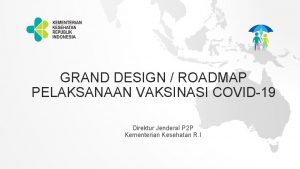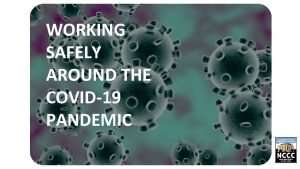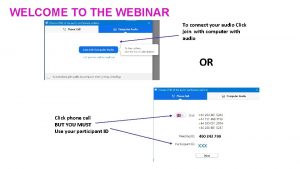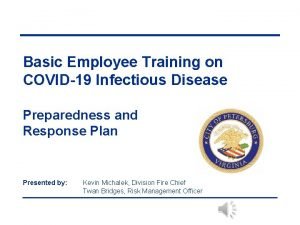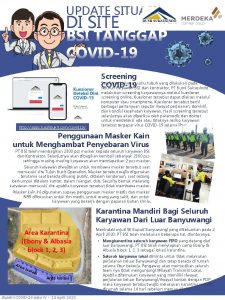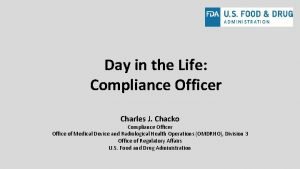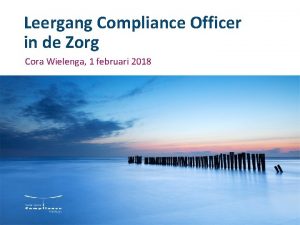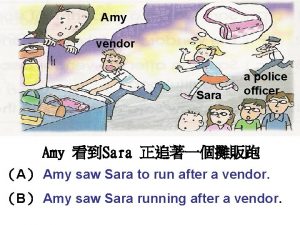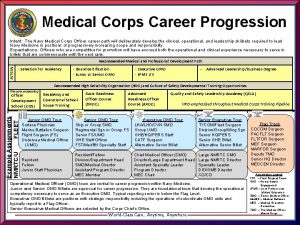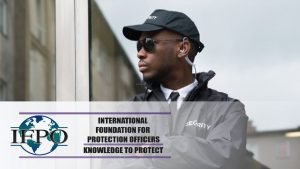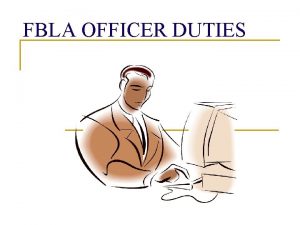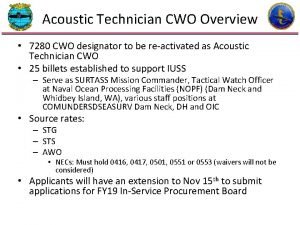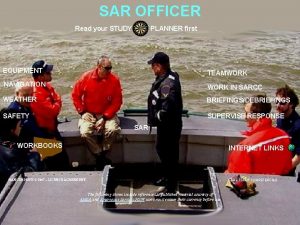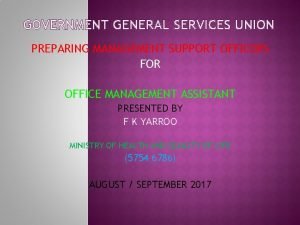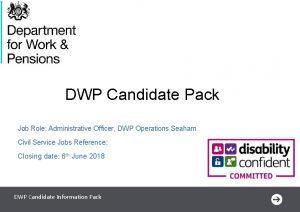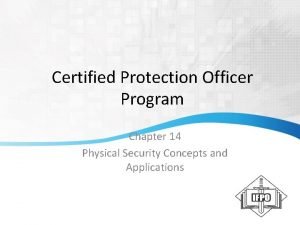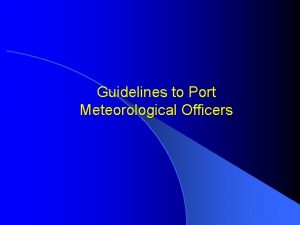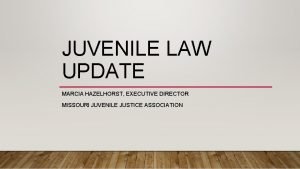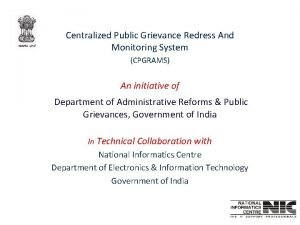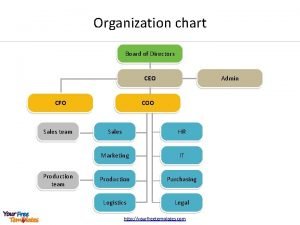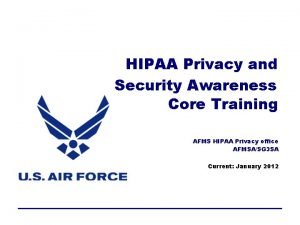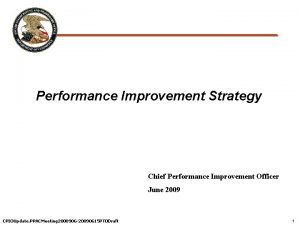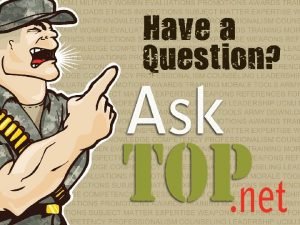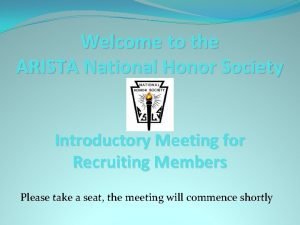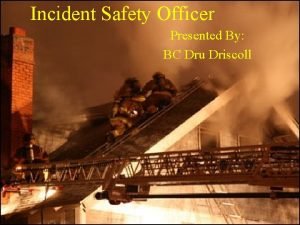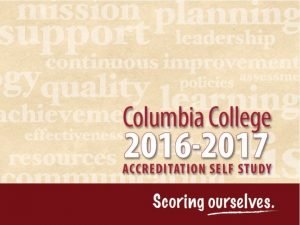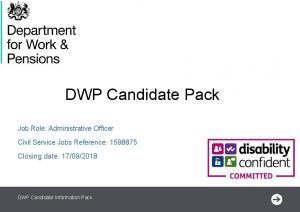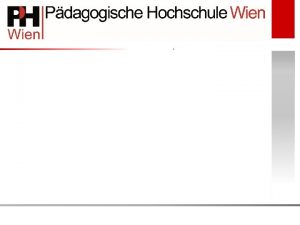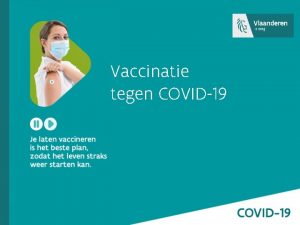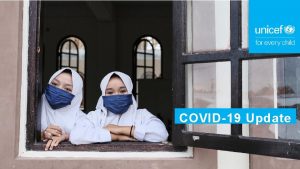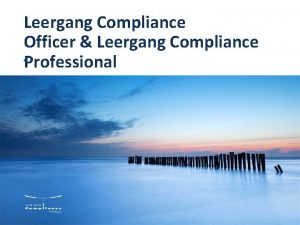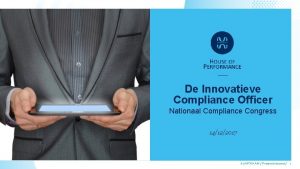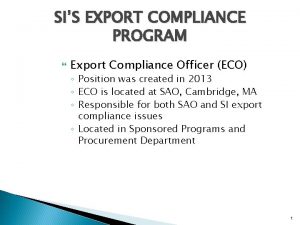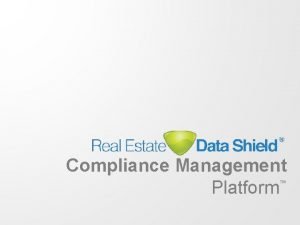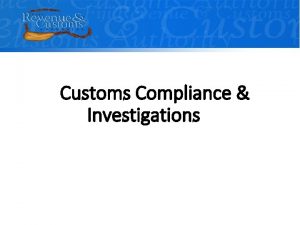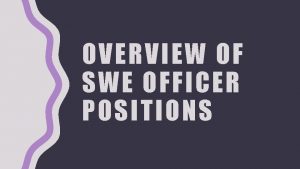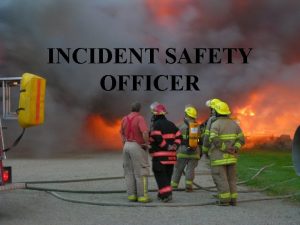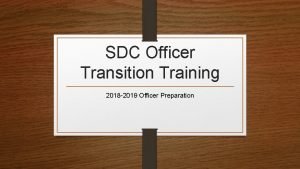COVID19 Compliance Officer C 19 CO Compliance Officer






































- Slides: 38

COVID-19 Compliance Officer C 19 CO

Compliance Officer Origins Lights, Camera, Action is being heard again across the country. As production begins again there is a need for a new crew position: The COVID-19 Compliance Officer (C 19 CO). Often times on production food is shared, people work closely with one another, and social distancing is a challenge. This course is designed to inform production crew about on-set protocols related to COVID-19. It will also provide the tools and resources for the new COVID-19 Compliance Officer (C 19 CO) position.

C 19 CO Course Purpose • This course is designed for all types of productions. Set Safety Standards are constantly changing and vary from city to city. Please consult your local health departments and check the latest CDC guidelines before each shoot. This course follows the guidelines set by: • The United States Department of Public Labor – Occupational Safety & Health Administration. • Health & Safety Guidelines for Motion Picture, Television & Streaming Productions presented by the Alliance of Motion Pictures and Television Producers Industry-wide Labor-Management Safety Committee Task Force White Paper. • General Workplace Safety Guidelines set by the CDC.

C 19 CO Course Outline • Covid-19 Overview and Q&A • Signs/Symptoms • Covid-19 Compliance Officer Role & Responsibility • Cast/Crew Responsibilities • Screening Procedures & Types of Covid-19 Tests • Infection Control – PPE & Social Distancing • Return to Work after Quarantine • Site Disinfection • Unique Production Specific Concerns • Contact Tracing • Resources

C 19 CO Does Not Replace A Set Medic The COVID-19 Compliance Officer (C 19 CO) does not replace a Set Medics are licensed or certified medical professionals. The position of C 19 CO is designed to relieve the Set Medic of many tasks and to prevent the spread of Covid-19 when a Set Medic is not available. • The role of a C 19 CO can be performed by a Set Medic. • A Set Medic can be assisted by a C 19 CO.

How is Covid-19 virus spread? Is it airborne, aerosolized or droplets in the air? The virus is not airborne - it does not fly. Droplets/contact and aerosolization are the main spread. More so droplets and contact in the public, thus the use of masks. COVID-19 is believed to spread mainly from person-to-person, between people who are in close contact with one another (within about 6 feet) or through respiratory droplets produced when an infected person coughs or sneezes. These droplets can land in the mouths or noses of people who are nearby or possibly be inhaled into the lungs. Spread is more likely when people are in close contact with one another (within about 6 feet).

Will the spread of Covid-19 end with warmer weather? We don't know if it will end with warmer weather. Qasim Bukhari and Yusuf Jameel, both from the Massachusetts Institute of Technology, analyzed global cases of the disease caused by the virus, COVID-19, and found that 90% of the infections occurred in areas that are between 37. 4 and 62. 6 degrees Fahrenheit. In countries with an average temperature greater than 64. 4 F and an absolute humidity greater than 9 g/m 3, the number of COVID-19 cases is less than 6% of the global cases. This suggests "that the transmission of 2019 -n. Co. V virus might have been less efficient in warmer humid climate so far, " the authors wrote. Humidity especially might play a role, given that most of the transmission of COVID-19 has happened in relatively less humid areas.

If I have antibodies to Covid-19, can I be reinfected by the same strain of it? We do not know if antibodies mean there is immunity at this point. The presumption is that it should be, but it is not clear. The antibody tests are uncertain as well as many of the usual COVID-19 tests. Most of these tests have not gone through rigorous review by the FDA and instead were pushed through quickly with the assumption that the manufacturer/producer of the tests have done it. Yet when you look at the testing done by the producer; it is often a very small number of test subjects. This is what is giving the high false negative rate of many of these tests. Patients seen in the ED with clear cut COVID end up with negative tests. It also depends on the specimen taken, if it is taken appropriately, if it is not a blood test, and also what point in the infection course it is. Some of these tests being offered at some urgent care centers are completely useless. The other question is whether the antibody test actually truly tests specifically for COVID-19 or other strains of coronavirus. For example, some people say they had symptoms in January. That may be a coronavirus causing the common cold (along with multiple other viruses that cause the common cold), and less likely COVID-19 which was widespread already especially since we were not seeing the type of patients in EMS nor the hospitals that we saw. In April. The World Health Organization (WHO) has warned against “immunity passports. ” Even if the tests were 100 percent accurate, we still don’t know whether antibodies to the new coronavirus will protect people from being re-infected. If they do confer protection, we don’t know whether it’s full or partial or how long it will last.

When do I need to wear a face covering? • If you are outside and alone, then you do not necessarily need to wear a face covering. But if there are others close by then it is recommended to wear a face covering. • If you are alone in your car or your house, you do not need to wear a face covering. • If you are close enough to exchange droplets with another person you DO need to wear a face covering.

Signs & Symptoms of Covid-19 • People with COVID-19 have had a wide range of symptoms reported – ranging from mild symptoms to severe illness. Symptoms may appear 2 -14 days after exposure to the virus. People with these symptoms may have COVID-19: • Fever or chills • Cough • Shortness of breath or difficulty breathing • Fatigue • Muscle or body aches • Headache • New loss of taste or smell • Sore throat • Congestion or runny nose • Nausea or vomiting

C 19 CO Role & Responsibilities Your primary function is prevention of the transmission of Covid-19. This is achieved by: • Ensuring the area is safe for people to enter. • Ensuring that those entering are asymptomatic and appear healthy. • Educating people about the need for safety in the area. • Ensuring the safety of the people in the area. • Monitoring people for compliance with safety guidelines. • Ensure signage is posted prominently with instructions on how to stop the spread of COVID-19, including hand hygiene and PPE instructions.

Cast & Crew Responsibilities • Hand Hygiene – Crew should ensure hand hygiene immediately after completing a task that may have exposure to germs. • Face Coverings - Cast and crew in close proximity must wear a face covering. • Social Distancing – Maintain a space large enough to accommodate 6 feet physical distancing in all directions. • HMU & Wardrobe - When maintaining physical distancing is not possible and the performer cannot wear appropriate PPE, contact must be kept to the shortest amount of time possible, and the other crew member must wear appropriate PPE. • Catering & Crafty - COVID-19 is unlikely to be spread through food or beverages; however, catering, crafts service and eating within workspaces present several unique challenges.

• Drivers - High-touch surfaces in vehicles (e. g. , steering wheels, controls, seatbelts, door handles, arm rests) shall be cleaned at least once per day and prior to a change in operator or passenger. • Dressing & Green Rooms - Personal equipment (such as tools, headsets, microphones and radios) shall be cleaned and disinfected before being issued and then at least once per day. • Video Village - Use technology options such as additional monitors and remote viewing. Equipment such as radios/walkietalkies should be issued to a single crew member and used exclusively by that crew member for the duration of production.

Screening Procedures Initial Impression - Sick/Not Sick Visual observation - at the door assessment of skin color, posture, turgor, eyes, posture, perspiration. Visual assessment. Note skin color, diaphoresis, runny nose, obvious COVID-19 symptoms or other abnormal condition. Form an objective opinion of the persons general wellbeing. If person presents with any abnormalities perform a complete patient assessment. Evaluate – Assessment & Diagnostic Tests Ability to communicate in a complete sentence. The following questions should randomly be incorporated into a conversation. Do you know anyone who has been diagnosed with Covid-19? Do you have a new or worsening cough today? ” Have you felt like you had a fever in the past day? ”

Diagnostic Tests • Temperature - Take the persons temperature using a temporal thermometer in a normal room temperature setting. If above 100. 4 perform a complete patient assessment. Because temporal temperature screening is adversely affected by environmental temperature and is an indication of body surface temperature, not body core temperature, temperature checks should be conducted in an environmentally stable area that is temperature controlled and unaffected by environmental conditions. • A baseline temperature is needed. The CO 19 CO should take their own temperature first with a contact thermometer and again with the non-contact thermometer. Note the environmental difference to adjust all crew temperatures to be taken.

Screening Procedures Diagnostic Tests • Pulse Oximetry – If the person does not have good oxygenation of the blood stream, they may have a respiratory problem like Covid-19. Anyone who has an SPO 2 below 92 -94% is getting ready to decompensate. • Blood Pressure – Low blood pressure is an indicator of an illness like Covid-19. • Capillary Refill – Poor circulation is an indicator of an illness like Covid-19.

Positive Test Actions • If any symptoms present during the complete patient assessment the person should be denied access and referred to a health care facility for further evaluation. • Provide a facemask for the person to wear over their nose and mouth. • Direct them to the area designated for symptomatic persons. • Metabolic Testing - Reverse-Transcriptase Polymerase chain reaction (RT-PCR). • Antigen Testing - SARS Antigen Fluorescent Immunoassay (FIA) • Antibody Testing - Ig. M and Ig. G antibodies to SARS-Co. V-2 virus

What is a COVID-19 PCR Test? Polymerase Chain Reaction (PCR) is a type of diagnostic test used to diagnose current infection in the acute phase for many infectious diseases. PCR testing is also called “nucleic acid testing” or “molecular testing” and tests for the presence of the genetic material of the virus. The COVID-19 PCR test is specific for SARS Co. V 2, the organism that causes COVID-19 illness, whether or not you have symptoms. A positive result means you are infected with SARS- Co. V 2, the organism that causes COVID-19, whether or not you have symptoms.

How is the COVID-19 PCR Test Collected? A Covid-19 PCR saliva test, is a non-invasive test involving a nasal swab. You can take your own specimen or have it collected by a technician. You should prepare for your test by not smoking, chewing gum, drinking or eating within 30 minutes before you provide your specimen. The test is read in a laboratory and results are usually available 24 -48 hours later.

Is the Saliva PCR Test FDA Approved? The PCR tests being used currently have received Emergency Use Authorization (EUA) from the FDA. An EUA allows the use of unapproved medical products, or unapproved uses of approved medical products, to diagnose, treat or prevent serious or life-threatening diseases when certain criteria are met, including that there are no adequate, approved and available alternatives. The FDA has not, as of yet, fully authorized any COVID-19 PCR testing.

Positive Antibody Result Interpreting Antibody Test Results • The body has likely produced an immune response. • No proof of immunity. • No proof of free of infection. • No proof not currently infected. • A “false positive” antibody result can happen if you have been exposed to other types of Coronavirus.

Negative Antibody Result • • A negative result means no antibody was found in the sample tested. It does not indicate “virus-free” or “infection-free”. It does not mean no exposure to the virus. Patients who are immune-compromised or are on immune-suppressing medications may test negative even thought they have been exposed to the virus.

Who Should Not Be On Set • Look for emergency warning signs for COVID-19. If someone is showing any of these signs, seek emergency medical care immediately • Trouble breathing • Persistent pain or pressure in the chest • New confusion • Inability to wake or stay awake • Bluish lips or face • This list is not all possible symptoms. Please call a medical provider or 911 for any other symptoms that are concerning to you.

Infection Control Techniques Personal Protective Equipment • Face Coverings - Unless you are a health care worker, medical masks (Healthcare Particulate respirators and N 95 s) are not recommended. Medical masks should be prioritized for health care workers providing care for patients. • Cloth face coverings can be made from household items such as 2 layers of cotton fabric, T-shirts, bandanas, or bedsheets. Masks should be secured with ear loops or ties. Whatever material a face mask is made from, it should fit well and cover the nose and mouth. The mask should not restrict the wearer’s ability to breathe. • Face shields come in various forms, but all provide a clear plastic barrier that covers the face. For optimal protection, the shield should extend below the chin anteriorly, to the ears laterally, and there should be no exposed gap between the forehead and the shield’s headpiece.

• Gloves - Use disposable gloves when cleaning and disinfecting areas or making direct skin contact with surfaces that may be frequently touched. After using disposable gloves, throw them out in a lined trash can. Do not disinfect or reuse the gloves. Wash your hands after you have removed the gloves. • Gowns – May be worn while cleaning or disinfecting to protect your clothes from exposure. • Glasses - May be worn while performing tasks where they eyes may be exposed.

Return to Work After Quarantine If you have COVID-19 and have symptoms, you may end home isolation under the following conditions: • At least three days have passed since recovery (defined as fever ending without the use of fever-reducing medications), and • You have experienced improvement in respiratory symptoms (e. g. , cough, shortness of breath), and • At least 10 days have passed since symptoms first appeared. If you have COVID-19 and have not had any symptoms, you may end home isolation under the following conditions: • At least 10 days have passed since the date

Site Disinfection • Cleaning with soap and water removes germs, dirt, and impurities from surfaces. It lowers the risk of spreading infection. • Disinfecting kills germs on surfaces. By killing germs on a surface after cleaning, it can further lower the risk of spreading infection. • Regular cleaning staff can clean and disinfect commonly used spaces. Cleaning staff should be trained on appropriate use of cleaning and disinfection chemicals and provided with the personal protective equipment (PPE) required for the chemicals used.

• Routine cleaning and disinfecting are an important part of reducing the risk of exposure to COVID-19. • Normal routine cleaning with soap and water alone can reduce risk of exposure and is a necessary step before you disinfect dirty surfaces. • Surfaces frequently touched by multiple people, such as door handles, desks, phones, light switches, and faucets, should be cleaned and disinfected at least daily. More frequent cleaning and disinfection may be required based on level of use.

• Some surfaces only need to be cleaned with soap and water. For example, surfaces and objects that are not frequently touched should be cleaned and do not require additional disinfection. Additionally, disinfectants should typically not be applied on items used by children, especially any items that children might put in their mouths. Many disinfectants are toxic when swallowed. In a household setting, cleaning toys and other items used by children with soap and water is usually sufficient. • Coronaviruses on surfaces and objects naturally die within hours to days. Warmer temperatures and exposure to sunlight will reduce the time the virus survives on surfaces and objects.

Unique Production Specific Concerns • The work of some cast and crew members (e. g. , hair stylists, make-up artists, costume designers, costumers, wardrobe department personnel, sound technicians, property persons, studio teachers and special effects technicians, etc. ) may not be possible while maintaining physical distancing from others. The performers with whom they work may not be able to wear face coverings at all times, for example when make-up is being applied. • Certain activities such as fight scenes or intimate scenes increase the risk of transmission.

• Castings & Auditions should be conducted virtually via selftape, online video conference, or other applicable technology. • As minors may have difficulty adhering to physical distancing, wearing PPE, and practicing hand hygiene, when not working, they should be relocated to a secure set location. • Filming on location can pose certain risks compared with shooting on a studio/stage set. Ensure access to clean facilities.

• Productions may have breaks over several days in the shooting schedule. Crew should be informed to adhere to the guidelines for proper risk reduction when not on a controlled set. • If needed crew members should be sent on break with additional PPE to be used at home to minimize risk. • Crew members should be made aware of potentially risky activities to avoid over the break. • Crew members should be made aware of the signs and symptoms of Covid-19 so they can be observant of the people they make contact with over the break.

Contact Tracing Contact tracing is the process of identifying, assessing, and managing people, or "contacts, " who have been exposed to a disease to prevent additional transmission. The objectives for COVID-19 contact tracing are to: • Identify and notify individuals who might have come in contact with a Person Under Investigation (PUI). • Identify to what extent the contact has been exposed to the PUI. • Establish if the contact is at risk of getting the virus themselves. • Provide the contact with appropriate guidance. This may include counseling them on how to prevent further spread of COVID-19 and linking or referring them to medical care and other prevention services.

As a CO 19 CO/Contact Tracer, you will collect important data that will help public health authorities track COVID-19 cases and determine if someone should be counted as a case. • The data collected during your interviews with PUIs and contacts will be considered confidential information, and that should be communicated during the interview. Examples of Confidential Information • Name • Date of birth • Address • Telephone number • Information of contacts • Medical history

Four Steps to Contact Tracing Step 1 - Initial notification of the Person Under Investigation (PUI). Contact tracing should be initiated as soon as possible after a PUI is identified. Step 2 - Interview the PUI. This should include a discussion about confidentiality, verification of demographic information and efforts to build trust. It might also be necessary to collect information to complete the case report and identify risk factors for severe illness such as underlying medical conditions. The interview will also involve walking through the entire infectious period hour-by-hour and asking the PUI to share who they were in contact with during that time.

• The infectious period may be defined as 48 hours before symptoms start, through the point when it’s safe for the PUI to stop isolation. • During this step, Contact Tracers will also identify contacts by asking about the PUI’s recent activities & who was around them during the infectious period. Contacts may include anyone who has been within six feet of a COVID-19 case for a prolonged period of time. Step 3 - Locate & notify contacts that may have been exposed to COVID-19. When contacts are identified & located, they should be informed of their contact status and what that means. Step 4 - Monitor contacts. Follow up with contacts to make sure they are following the quarantine instructions, and to track the development of any potential COVID-19 symptoms.

Resources https: //www. cdc. gov/coronavirus/2019 -ncov/faq. html https: //www. fema. gov/coronavirus/rumor-control https: //www. coronavirus. gov/ https: //usa. gov/coronavirus https: //www. oig. hhs. gov/coronavirus https: //www. osha. gov/SLTC/covid-19/standards. html https: //www. who. int/publications-detail/clinical-management-of-covid 19 • https: //www. epa. gov/pesticide-registration/list-n-disinfectants-useagainst-sars-cov-2 • •

Thank You For Your Time Questions?
 Vaksin covid19
Vaksin covid19 Do if you covid19
Do if you covid19 Covid19 athome rapid what know
Covid19 athome rapid what know What do if test positive covid19
What do if test positive covid19 Http//apps.tujuhbukit.com/covid19
Http//apps.tujuhbukit.com/covid19 A day in the life of a compliance officer
A day in the life of a compliance officer Zorg controller leergang
Zorg controller leergang Ipes enablement
Ipes enablement Navy supply officer career path
Navy supply officer career path Ifpo certified protection officer
Ifpo certified protection officer Adolfo gonzales chief probation officer
Adolfo gonzales chief probation officer Chief reality officer
Chief reality officer Ibm chief data officer
Ibm chief data officer Fbla president duties
Fbla president duties Chief data officer training
Chief data officer training Acoustic warrant officer
Acoustic warrant officer Officers portal
Officers portal Beep test prison officer
Beep test prison officer Tygron
Tygron Management support officer psc
Management support officer psc Dwp administrative officer interview questions
Dwp administrative officer interview questions Certified protection officer
Certified protection officer Aefi surveillance officer
Aefi surveillance officer Evacuation officer
Evacuation officer Port meteorological officer
Port meteorological officer A dangerous whirlpool personified as a female sea monster
A dangerous whirlpool personified as a female sea monster Missouri juvenile officer performance standards
Missouri juvenile officer performance standards Worksheet of defence officer wahida
Worksheet of defence officer wahida Disbursing officer duties and responsibilities
Disbursing officer duties and responsibilities Cpgrams login
Cpgrams login Ceo hierarchy chart
Ceo hierarchy chart Hipaa training air force
Hipaa training air force Chief improvement officer
Chief improvement officer Da form 2166 8
Da form 2166 8 Arista national honor society
Arista national honor society Florida incident safety officer
Florida incident safety officer Accreditation liaison officer
Accreditation liaison officer What does the owl represent in the ffa emblem?
What does the owl represent in the ffa emblem? Dwp administrative officer
Dwp administrative officer
